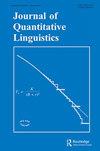用于分析模式及其分布语义的单词嵌入模型
IF 1.7
2区 文学
0 LANGUAGE & LINGUISTICS
引用次数: 4
摘要
自然语言处理的最新进展促进了机器学习和计算语言学社区在设计算法以生成词的上下文向量表示或词嵌入方面的积极研究。现有的研究很少关注词的模式,它编码了丰富的语义信息,并对词的上下文施加了语义约束。本文探讨了将词嵌入与模式语法(一种描述词汇项句法环境的语法模型)相结合的可行性。具体而言,本研究开发了一种基于词嵌入语义信息的模式提取方法,并研究了提取模式的统计规律和分布语义。本文的主要研究结果如下:在LCMC汉语语料库上的实验表明,模式出现的频率符合Zipf假设,且模式出现的频率与模式长度呈负相关。因此,该方法可以研究大规模语料库中模式的分布特性。此外,实验表明,我们提取的模式对上下文施加了语义约束,证明模式编码了丰富的语义和上下文信息。这揭示了基于模式的词嵌入在广泛的自然语言处理任务中的潜在应用。本文章由计算机程序翻译,如有差异,请以英文原文为准。
A Word Embedding Model for Analyzing Patterns and Their Distributional Semantics
ABSTRACT Recent advances in natural language processing have catalysed active research in designing algorithms to generate contextual vector representations of words, or word embedding, in the machine learning and computational linguistics community. Existing works pay little attention to patterns of words, which encode rich semantic information and impose semantic constraints on a word’s context. This paper explores the feasibility of incorporating word embedding with pattern grammar, a grammar model to describe the syntactic environment of lexical items. Specifically, this research develops a method to extract patterns with semantic information of word embedding and investigates the statistical regularities and distributional semantics of the extracted patterns. The major results of this paper are as follows. Experiments on the LCMC Chinese corpus reveal that the frequency of patterns follows Zipf’s hypothesis, and the frequency and pattern length are inversely related. Therefore, the proposed method enables the study of distributional properties of patterns in large-scale corpora. Furthermore, experiments illustrate that our extracted patterns impose semantic constraints on context, proving that patterns encode rich semantic and contextual information. This sheds light on the potential applications of pattern-based word embedding in a wide range of natural language processing tasks.
求助全文
通过发布文献求助,成功后即可免费获取论文全文。
去求助
来源期刊

Journal of Quantitative Linguistics
Multiple-
CiteScore
2.90
自引率
7.10%
发文量
7
期刊介绍:
The Journal of Quantitative Linguistics is an international forum for the publication and discussion of research on the quantitative characteristics of language and text in an exact mathematical form. This approach, which is of growing interest, opens up important and exciting theoretical perspectives, as well as solutions for a wide range of practical problems such as machine learning or statistical parsing, by introducing into linguistics the methods and models of advanced scientific disciplines such as the natural sciences, economics, and psychology.
 求助内容:
求助内容: 应助结果提醒方式:
应助结果提醒方式:


